University Sports Performance: Dan Rodriguez Football Analysis Report
VerifiedAdded on 2021/04/16
|13
|3381
|37
Report
AI Summary
This report presents an analysis of Dan Rodriguez, a football player, focusing on his ball control skills. The study investigates physical, technical, social, psychological, and tactical factors affecting his performance. It utilizes both primary and secondary data, including questionnaires and interviews, to identify weaknesses and underlying causes, such as limited training time due to academic commitments, inadequate training facilities, and social factors impacting his focus. Psychological aspects like confidence and target setting are also evaluated. The report highlights the importance of regular training, quality facilities, and psychological resilience. The analysis leads to the development of a performance improvement plan with recommendations for enhancing ball control through improved training techniques, psychological support, and tactical adjustments. The report emphasizes the need for Dan to allocate more time for training, improve the training equipment and focus on his psychological aspects to excel in his sport.

1
SPORTS PERFORMANCE
Student’s Name
Code + Course Name
Professor’s Name
University Name
City, State
Date
SPORTS PERFORMANCE
Student’s Name
Code + Course Name
Professor’s Name
University Name
City, State
Date
Paraphrase This Document
Need a fresh take? Get an instant paraphrase of this document with our AI Paraphraser
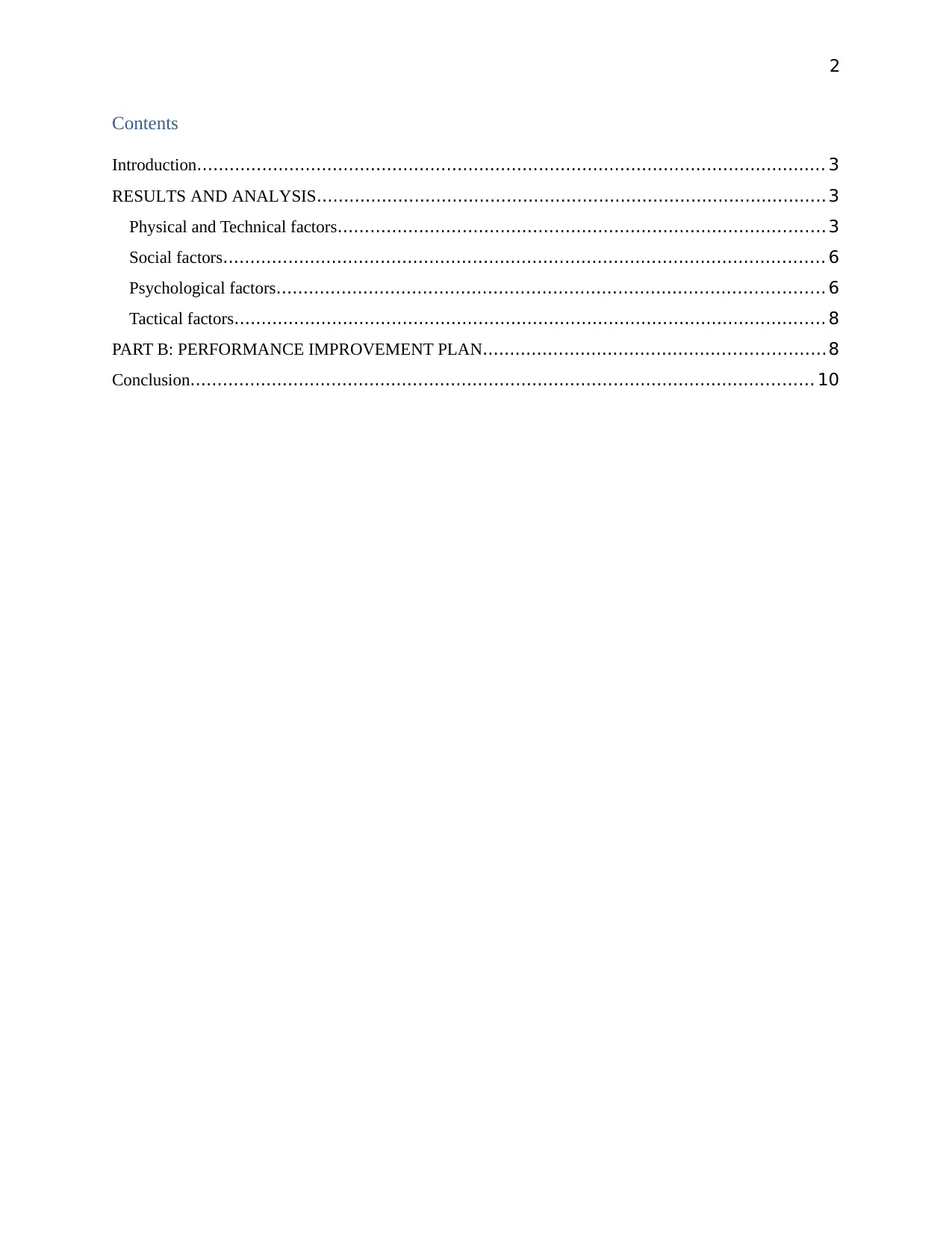
2
Contents
Introduction.................................................................................................................... 3
RESULTS AND ANALYSIS.............................................................................................. 3
Physical and Technical factors.......................................................................................... 3
Social factors............................................................................................................... 6
Psychological factors..................................................................................................... 6
Tactical factors............................................................................................................. 8
PART B: PERFORMANCE IMPROVEMENT PLAN...............................................................8
Conclusion................................................................................................................... 10
Contents
Introduction.................................................................................................................... 3
RESULTS AND ANALYSIS.............................................................................................. 3
Physical and Technical factors.......................................................................................... 3
Social factors............................................................................................................... 6
Psychological factors..................................................................................................... 6
Tactical factors............................................................................................................. 8
PART B: PERFORMANCE IMPROVEMENT PLAN...............................................................8
Conclusion................................................................................................................... 10
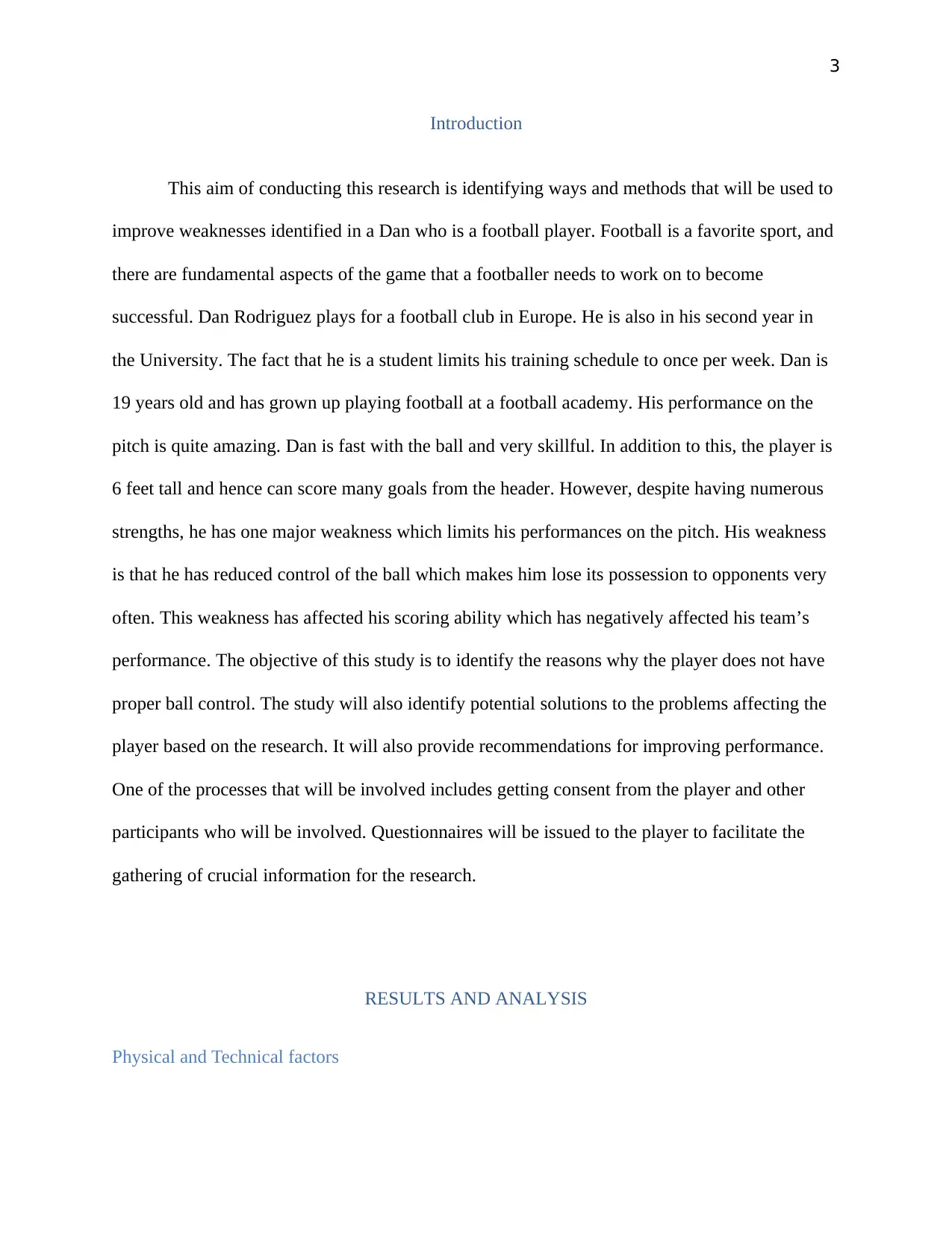
3
Introduction
This aim of conducting this research is identifying ways and methods that will be used to
improve weaknesses identified in a Dan who is a football player. Football is a favorite sport, and
there are fundamental aspects of the game that a footballer needs to work on to become
successful. Dan Rodriguez plays for a football club in Europe. He is also in his second year in
the University. The fact that he is a student limits his training schedule to once per week. Dan is
19 years old and has grown up playing football at a football academy. His performance on the
pitch is quite amazing. Dan is fast with the ball and very skillful. In addition to this, the player is
6 feet tall and hence can score many goals from the header. However, despite having numerous
strengths, he has one major weakness which limits his performances on the pitch. His weakness
is that he has reduced control of the ball which makes him lose its possession to opponents very
often. This weakness has affected his scoring ability which has negatively affected his team’s
performance. The objective of this study is to identify the reasons why the player does not have
proper ball control. The study will also identify potential solutions to the problems affecting the
player based on the research. It will also provide recommendations for improving performance.
One of the processes that will be involved includes getting consent from the player and other
participants who will be involved. Questionnaires will be issued to the player to facilitate the
gathering of crucial information for the research.
RESULTS AND ANALYSIS
Physical and Technical factors
Introduction
This aim of conducting this research is identifying ways and methods that will be used to
improve weaknesses identified in a Dan who is a football player. Football is a favorite sport, and
there are fundamental aspects of the game that a footballer needs to work on to become
successful. Dan Rodriguez plays for a football club in Europe. He is also in his second year in
the University. The fact that he is a student limits his training schedule to once per week. Dan is
19 years old and has grown up playing football at a football academy. His performance on the
pitch is quite amazing. Dan is fast with the ball and very skillful. In addition to this, the player is
6 feet tall and hence can score many goals from the header. However, despite having numerous
strengths, he has one major weakness which limits his performances on the pitch. His weakness
is that he has reduced control of the ball which makes him lose its possession to opponents very
often. This weakness has affected his scoring ability which has negatively affected his team’s
performance. The objective of this study is to identify the reasons why the player does not have
proper ball control. The study will also identify potential solutions to the problems affecting the
player based on the research. It will also provide recommendations for improving performance.
One of the processes that will be involved includes getting consent from the player and other
participants who will be involved. Questionnaires will be issued to the player to facilitate the
gathering of crucial information for the research.
RESULTS AND ANALYSIS
Physical and Technical factors
⊘ This is a preview!⊘
Do you want full access?
Subscribe today to unlock all pages.

Trusted by 1+ million students worldwide
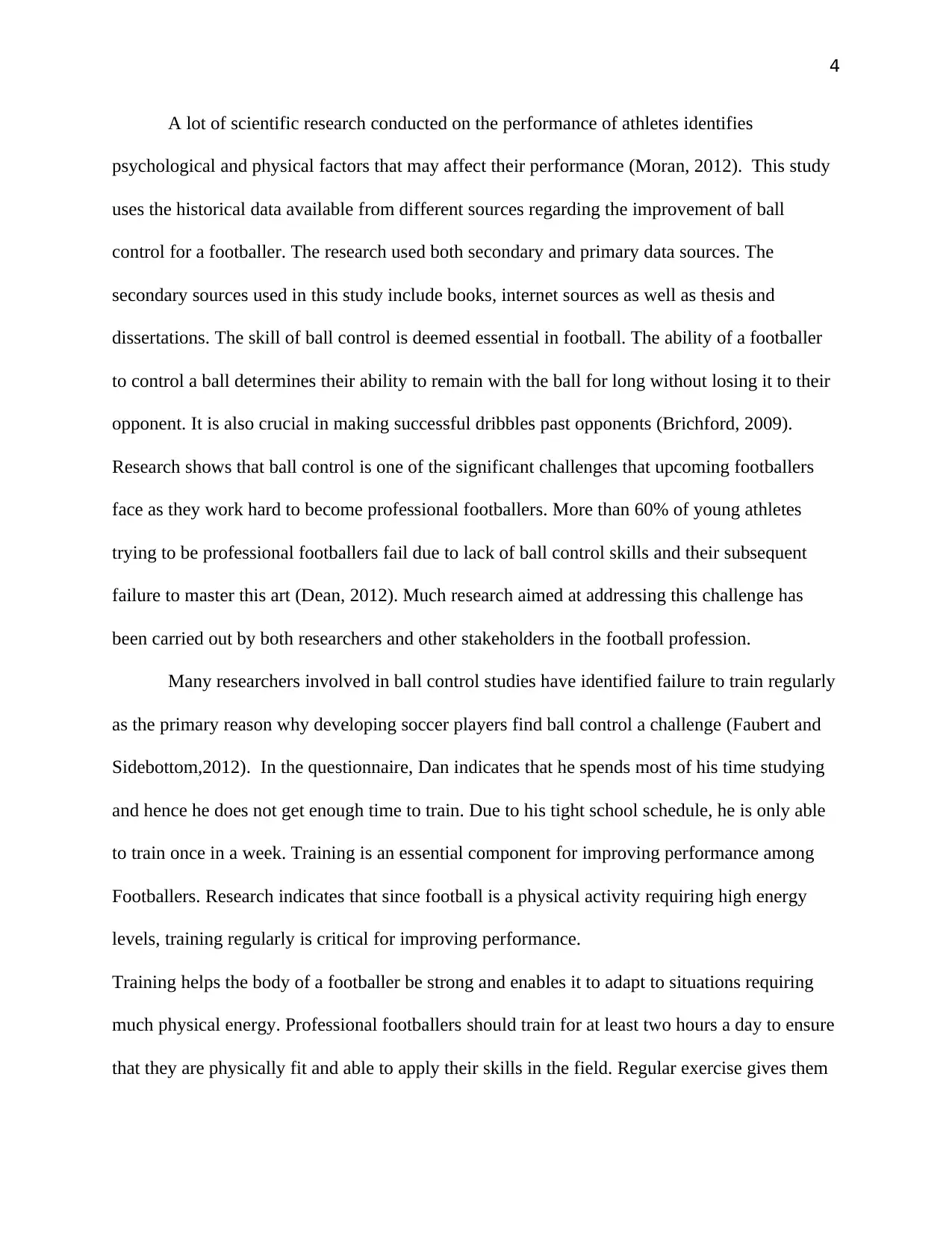
4
A lot of scientific research conducted on the performance of athletes identifies
psychological and physical factors that may affect their performance (Moran, 2012). This study
uses the historical data available from different sources regarding the improvement of ball
control for a footballer. The research used both secondary and primary data sources. The
secondary sources used in this study include books, internet sources as well as thesis and
dissertations. The skill of ball control is deemed essential in football. The ability of a footballer
to control a ball determines their ability to remain with the ball for long without losing it to their
opponent. It is also crucial in making successful dribbles past opponents (Brichford, 2009).
Research shows that ball control is one of the significant challenges that upcoming footballers
face as they work hard to become professional footballers. More than 60% of young athletes
trying to be professional footballers fail due to lack of ball control skills and their subsequent
failure to master this art (Dean, 2012). Much research aimed at addressing this challenge has
been carried out by both researchers and other stakeholders in the football profession.
Many researchers involved in ball control studies have identified failure to train regularly
as the primary reason why developing soccer players find ball control a challenge (Faubert and
Sidebottom,2012). In the questionnaire, Dan indicates that he spends most of his time studying
and hence he does not get enough time to train. Due to his tight school schedule, he is only able
to train once in a week. Training is an essential component for improving performance among
Footballers. Research indicates that since football is a physical activity requiring high energy
levels, training regularly is critical for improving performance.
Training helps the body of a footballer be strong and enables it to adapt to situations requiring
much physical energy. Professional footballers should train for at least two hours a day to ensure
that they are physically fit and able to apply their skills in the field. Regular exercise gives them
A lot of scientific research conducted on the performance of athletes identifies
psychological and physical factors that may affect their performance (Moran, 2012). This study
uses the historical data available from different sources regarding the improvement of ball
control for a footballer. The research used both secondary and primary data sources. The
secondary sources used in this study include books, internet sources as well as thesis and
dissertations. The skill of ball control is deemed essential in football. The ability of a footballer
to control a ball determines their ability to remain with the ball for long without losing it to their
opponent. It is also crucial in making successful dribbles past opponents (Brichford, 2009).
Research shows that ball control is one of the significant challenges that upcoming footballers
face as they work hard to become professional footballers. More than 60% of young athletes
trying to be professional footballers fail due to lack of ball control skills and their subsequent
failure to master this art (Dean, 2012). Much research aimed at addressing this challenge has
been carried out by both researchers and other stakeholders in the football profession.
Many researchers involved in ball control studies have identified failure to train regularly
as the primary reason why developing soccer players find ball control a challenge (Faubert and
Sidebottom,2012). In the questionnaire, Dan indicates that he spends most of his time studying
and hence he does not get enough time to train. Due to his tight school schedule, he is only able
to train once in a week. Training is an essential component for improving performance among
Footballers. Research indicates that since football is a physical activity requiring high energy
levels, training regularly is critical for improving performance.
Training helps the body of a footballer be strong and enables it to adapt to situations requiring
much physical energy. Professional footballers should train for at least two hours a day to ensure
that they are physically fit and able to apply their skills in the field. Regular exercise gives them
Paraphrase This Document
Need a fresh take? Get an instant paraphrase of this document with our AI Paraphraser
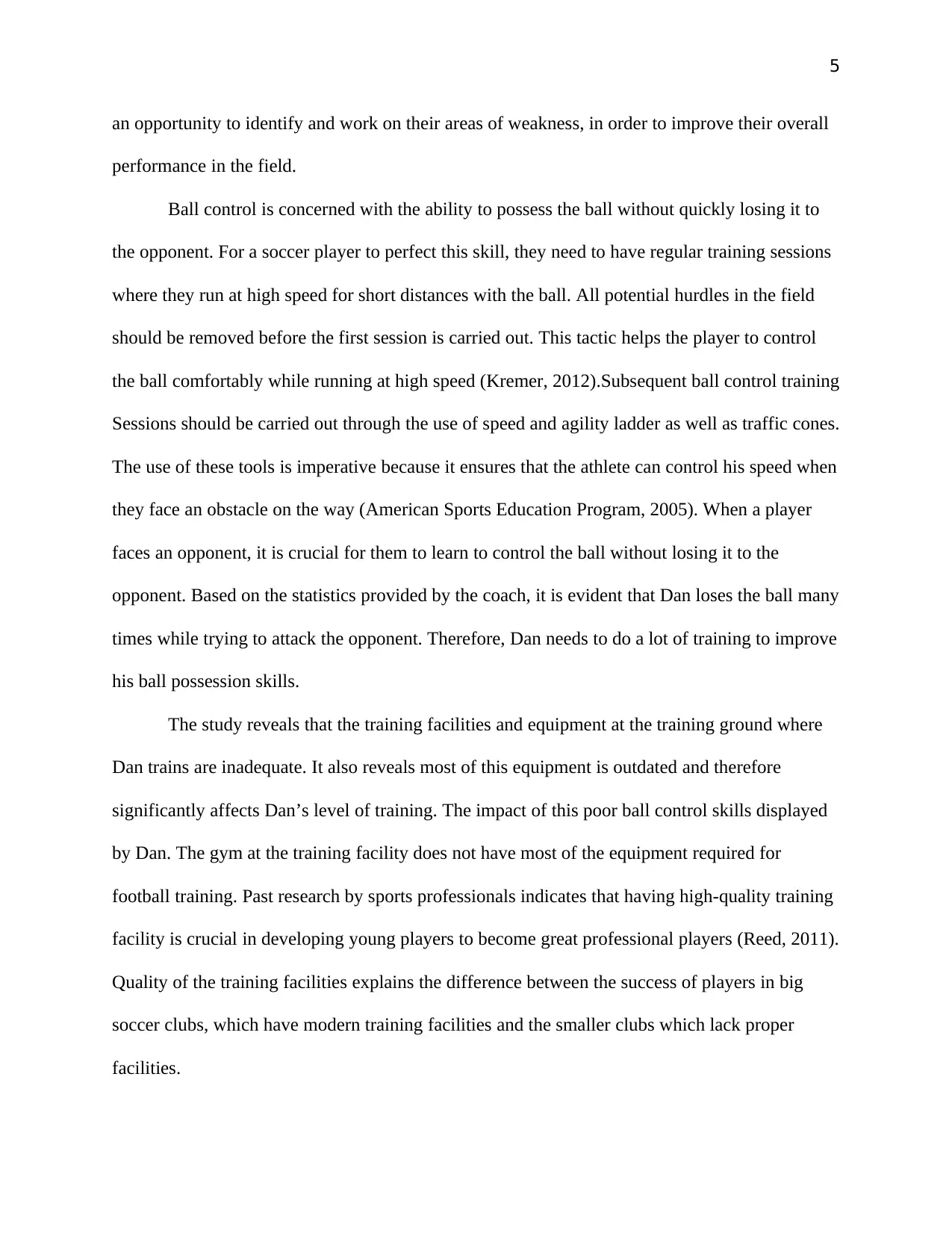
5
an opportunity to identify and work on their areas of weakness, in order to improve their overall
performance in the field.
Ball control is concerned with the ability to possess the ball without quickly losing it to
the opponent. For a soccer player to perfect this skill, they need to have regular training sessions
where they run at high speed for short distances with the ball. All potential hurdles in the field
should be removed before the first session is carried out. This tactic helps the player to control
the ball comfortably while running at high speed (Kremer, 2012).Subsequent ball control training
Sessions should be carried out through the use of speed and agility ladder as well as traffic cones.
The use of these tools is imperative because it ensures that the athlete can control his speed when
they face an obstacle on the way (American Sports Education Program, 2005). When a player
faces an opponent, it is crucial for them to learn to control the ball without losing it to the
opponent. Based on the statistics provided by the coach, it is evident that Dan loses the ball many
times while trying to attack the opponent. Therefore, Dan needs to do a lot of training to improve
his ball possession skills.
The study reveals that the training facilities and equipment at the training ground where
Dan trains are inadequate. It also reveals most of this equipment is outdated and therefore
significantly affects Dan’s level of training. The impact of this poor ball control skills displayed
by Dan. The gym at the training facility does not have most of the equipment required for
football training. Past research by sports professionals indicates that having high-quality training
facility is crucial in developing young players to become great professional players (Reed, 2011).
Quality of the training facilities explains the difference between the success of players in big
soccer clubs, which have modern training facilities and the smaller clubs which lack proper
facilities.
an opportunity to identify and work on their areas of weakness, in order to improve their overall
performance in the field.
Ball control is concerned with the ability to possess the ball without quickly losing it to
the opponent. For a soccer player to perfect this skill, they need to have regular training sessions
where they run at high speed for short distances with the ball. All potential hurdles in the field
should be removed before the first session is carried out. This tactic helps the player to control
the ball comfortably while running at high speed (Kremer, 2012).Subsequent ball control training
Sessions should be carried out through the use of speed and agility ladder as well as traffic cones.
The use of these tools is imperative because it ensures that the athlete can control his speed when
they face an obstacle on the way (American Sports Education Program, 2005). When a player
faces an opponent, it is crucial for them to learn to control the ball without losing it to the
opponent. Based on the statistics provided by the coach, it is evident that Dan loses the ball many
times while trying to attack the opponent. Therefore, Dan needs to do a lot of training to improve
his ball possession skills.
The study reveals that the training facilities and equipment at the training ground where
Dan trains are inadequate. It also reveals most of this equipment is outdated and therefore
significantly affects Dan’s level of training. The impact of this poor ball control skills displayed
by Dan. The gym at the training facility does not have most of the equipment required for
football training. Past research by sports professionals indicates that having high-quality training
facility is crucial in developing young players to become great professional players (Reed, 2011).
Quality of the training facilities explains the difference between the success of players in big
soccer clubs, which have modern training facilities and the smaller clubs which lack proper
facilities.
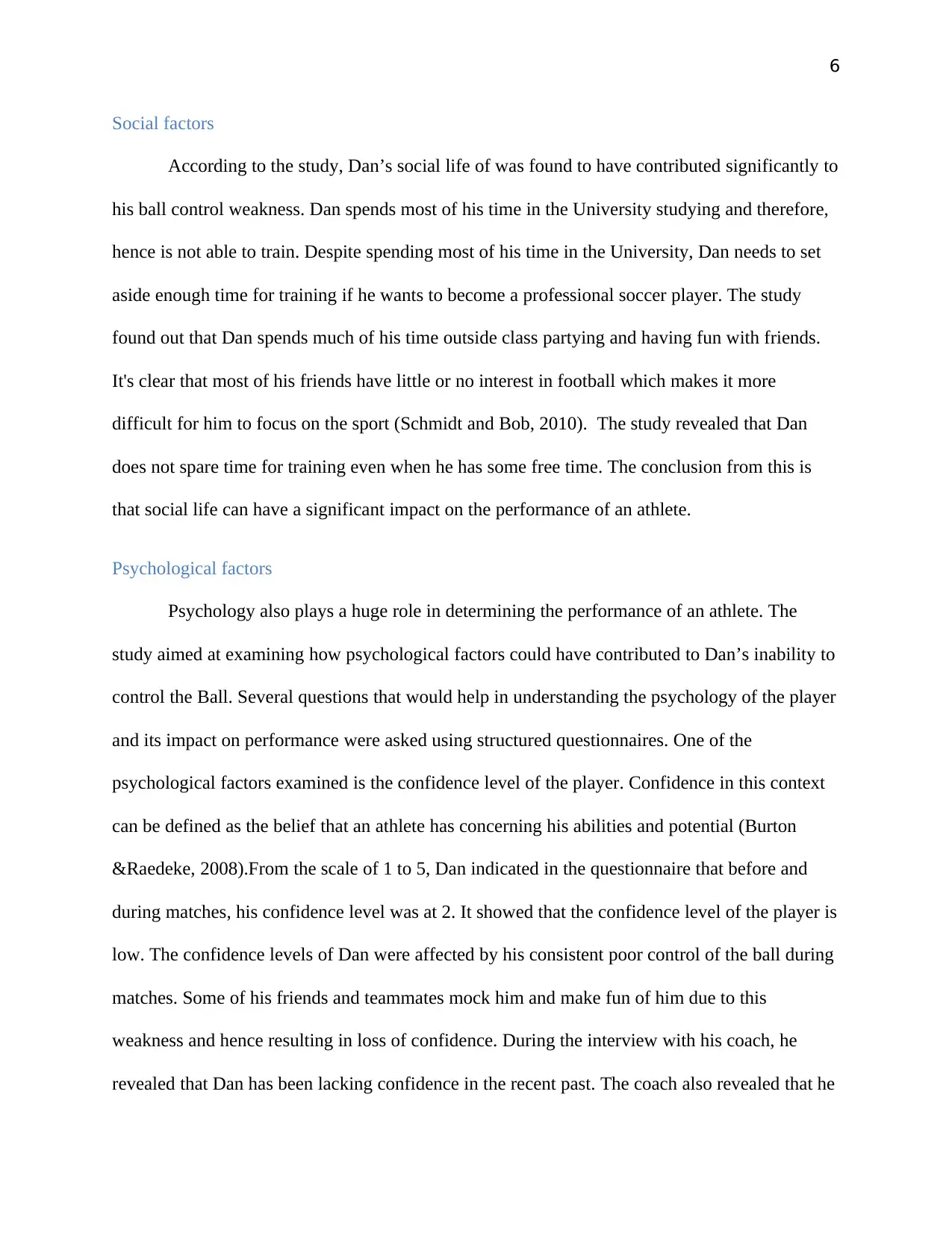
6
Social factors
According to the study, Dan’s social life of was found to have contributed significantly to
his ball control weakness. Dan spends most of his time in the University studying and therefore,
hence is not able to train. Despite spending most of his time in the University, Dan needs to set
aside enough time for training if he wants to become a professional soccer player. The study
found out that Dan spends much of his time outside class partying and having fun with friends.
It's clear that most of his friends have little or no interest in football which makes it more
difficult for him to focus on the sport (Schmidt and Bob, 2010). The study revealed that Dan
does not spare time for training even when he has some free time. The conclusion from this is
that social life can have a significant impact on the performance of an athlete.
Psychological factors
Psychology also plays a huge role in determining the performance of an athlete. The
study aimed at examining how psychological factors could have contributed to Dan’s inability to
control the Ball. Several questions that would help in understanding the psychology of the player
and its impact on performance were asked using structured questionnaires. One of the
psychological factors examined is the confidence level of the player. Confidence in this context
can be defined as the belief that an athlete has concerning his abilities and potential (Burton
&Raedeke, 2008).From the scale of 1 to 5, Dan indicated in the questionnaire that before and
during matches, his confidence level was at 2. It showed that the confidence level of the player is
low. The confidence levels of Dan were affected by his consistent poor control of the ball during
matches. Some of his friends and teammates mock him and make fun of him due to this
weakness and hence resulting in loss of confidence. During the interview with his coach, he
revealed that Dan has been lacking confidence in the recent past. The coach also revealed that he
Social factors
According to the study, Dan’s social life of was found to have contributed significantly to
his ball control weakness. Dan spends most of his time in the University studying and therefore,
hence is not able to train. Despite spending most of his time in the University, Dan needs to set
aside enough time for training if he wants to become a professional soccer player. The study
found out that Dan spends much of his time outside class partying and having fun with friends.
It's clear that most of his friends have little or no interest in football which makes it more
difficult for him to focus on the sport (Schmidt and Bob, 2010). The study revealed that Dan
does not spare time for training even when he has some free time. The conclusion from this is
that social life can have a significant impact on the performance of an athlete.
Psychological factors
Psychology also plays a huge role in determining the performance of an athlete. The
study aimed at examining how psychological factors could have contributed to Dan’s inability to
control the Ball. Several questions that would help in understanding the psychology of the player
and its impact on performance were asked using structured questionnaires. One of the
psychological factors examined is the confidence level of the player. Confidence in this context
can be defined as the belief that an athlete has concerning his abilities and potential (Burton
&Raedeke, 2008).From the scale of 1 to 5, Dan indicated in the questionnaire that before and
during matches, his confidence level was at 2. It showed that the confidence level of the player is
low. The confidence levels of Dan were affected by his consistent poor control of the ball during
matches. Some of his friends and teammates mock him and make fun of him due to this
weakness and hence resulting in loss of confidence. During the interview with his coach, he
revealed that Dan has been lacking confidence in the recent past. The coach also revealed that he
⊘ This is a preview!⊘
Do you want full access?
Subscribe today to unlock all pages.

Trusted by 1+ million students worldwide
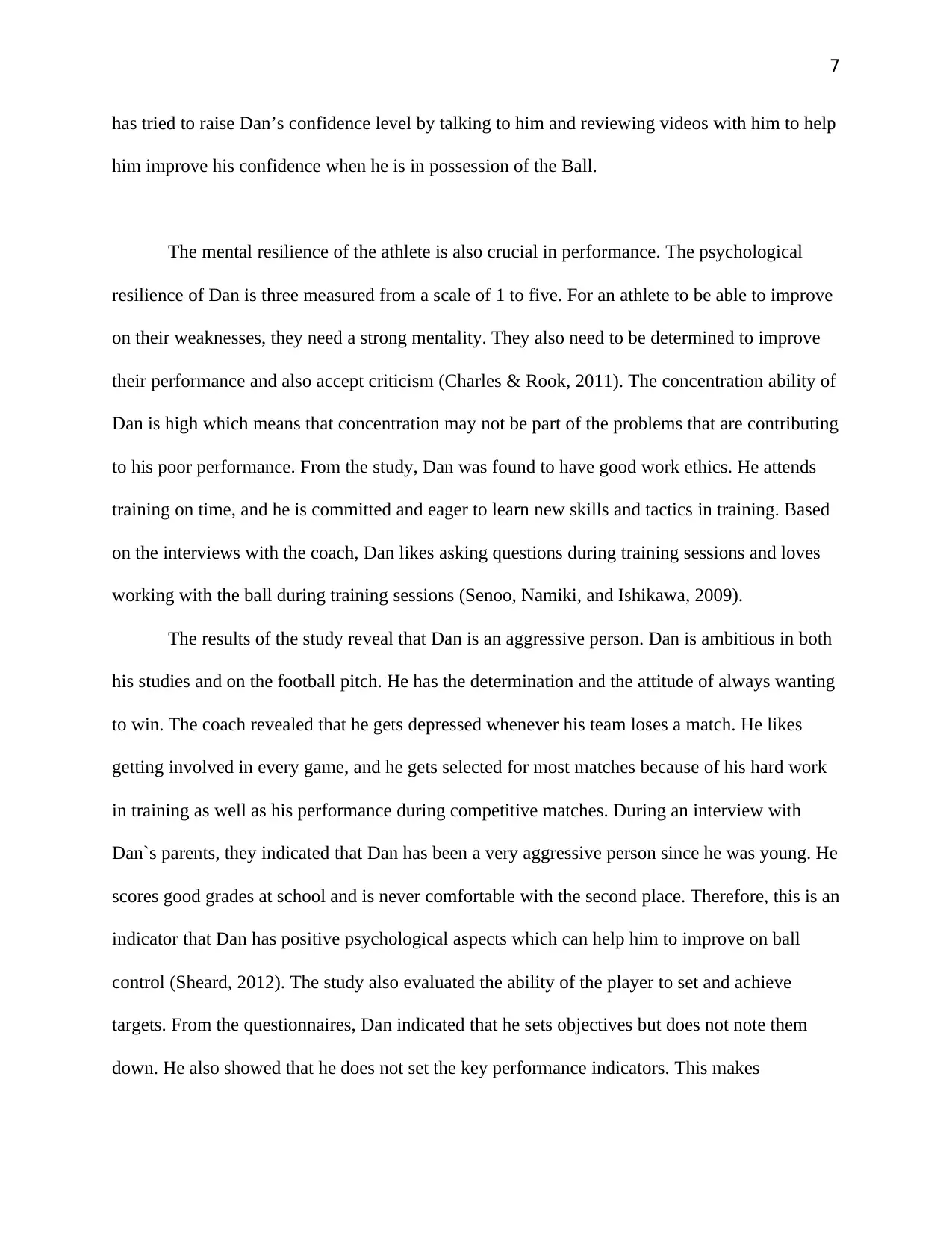
7
has tried to raise Dan’s confidence level by talking to him and reviewing videos with him to help
him improve his confidence when he is in possession of the Ball.
The mental resilience of the athlete is also crucial in performance. The psychological
resilience of Dan is three measured from a scale of 1 to five. For an athlete to be able to improve
on their weaknesses, they need a strong mentality. They also need to be determined to improve
their performance and also accept criticism (Charles & Rook, 2011). The concentration ability of
Dan is high which means that concentration may not be part of the problems that are contributing
to his poor performance. From the study, Dan was found to have good work ethics. He attends
training on time, and he is committed and eager to learn new skills and tactics in training. Based
on the interviews with the coach, Dan likes asking questions during training sessions and loves
working with the ball during training sessions (Senoo, Namiki, and Ishikawa, 2009).
The results of the study reveal that Dan is an aggressive person. Dan is ambitious in both
his studies and on the football pitch. He has the determination and the attitude of always wanting
to win. The coach revealed that he gets depressed whenever his team loses a match. He likes
getting involved in every game, and he gets selected for most matches because of his hard work
in training as well as his performance during competitive matches. During an interview with
Dan`s parents, they indicated that Dan has been a very aggressive person since he was young. He
scores good grades at school and is never comfortable with the second place. Therefore, this is an
indicator that Dan has positive psychological aspects which can help him to improve on ball
control (Sheard, 2012). The study also evaluated the ability of the player to set and achieve
targets. From the questionnaires, Dan indicated that he sets objectives but does not note them
down. He also showed that he does not set the key performance indicators. This makes
has tried to raise Dan’s confidence level by talking to him and reviewing videos with him to help
him improve his confidence when he is in possession of the Ball.
The mental resilience of the athlete is also crucial in performance. The psychological
resilience of Dan is three measured from a scale of 1 to five. For an athlete to be able to improve
on their weaknesses, they need a strong mentality. They also need to be determined to improve
their performance and also accept criticism (Charles & Rook, 2011). The concentration ability of
Dan is high which means that concentration may not be part of the problems that are contributing
to his poor performance. From the study, Dan was found to have good work ethics. He attends
training on time, and he is committed and eager to learn new skills and tactics in training. Based
on the interviews with the coach, Dan likes asking questions during training sessions and loves
working with the ball during training sessions (Senoo, Namiki, and Ishikawa, 2009).
The results of the study reveal that Dan is an aggressive person. Dan is ambitious in both
his studies and on the football pitch. He has the determination and the attitude of always wanting
to win. The coach revealed that he gets depressed whenever his team loses a match. He likes
getting involved in every game, and he gets selected for most matches because of his hard work
in training as well as his performance during competitive matches. During an interview with
Dan`s parents, they indicated that Dan has been a very aggressive person since he was young. He
scores good grades at school and is never comfortable with the second place. Therefore, this is an
indicator that Dan has positive psychological aspects which can help him to improve on ball
control (Sheard, 2012). The study also evaluated the ability of the player to set and achieve
targets. From the questionnaires, Dan indicated that he sets objectives but does not note them
down. He also showed that he does not set the key performance indicators. This makes
Paraphrase This Document
Need a fresh take? Get an instant paraphrase of this document with our AI Paraphraser
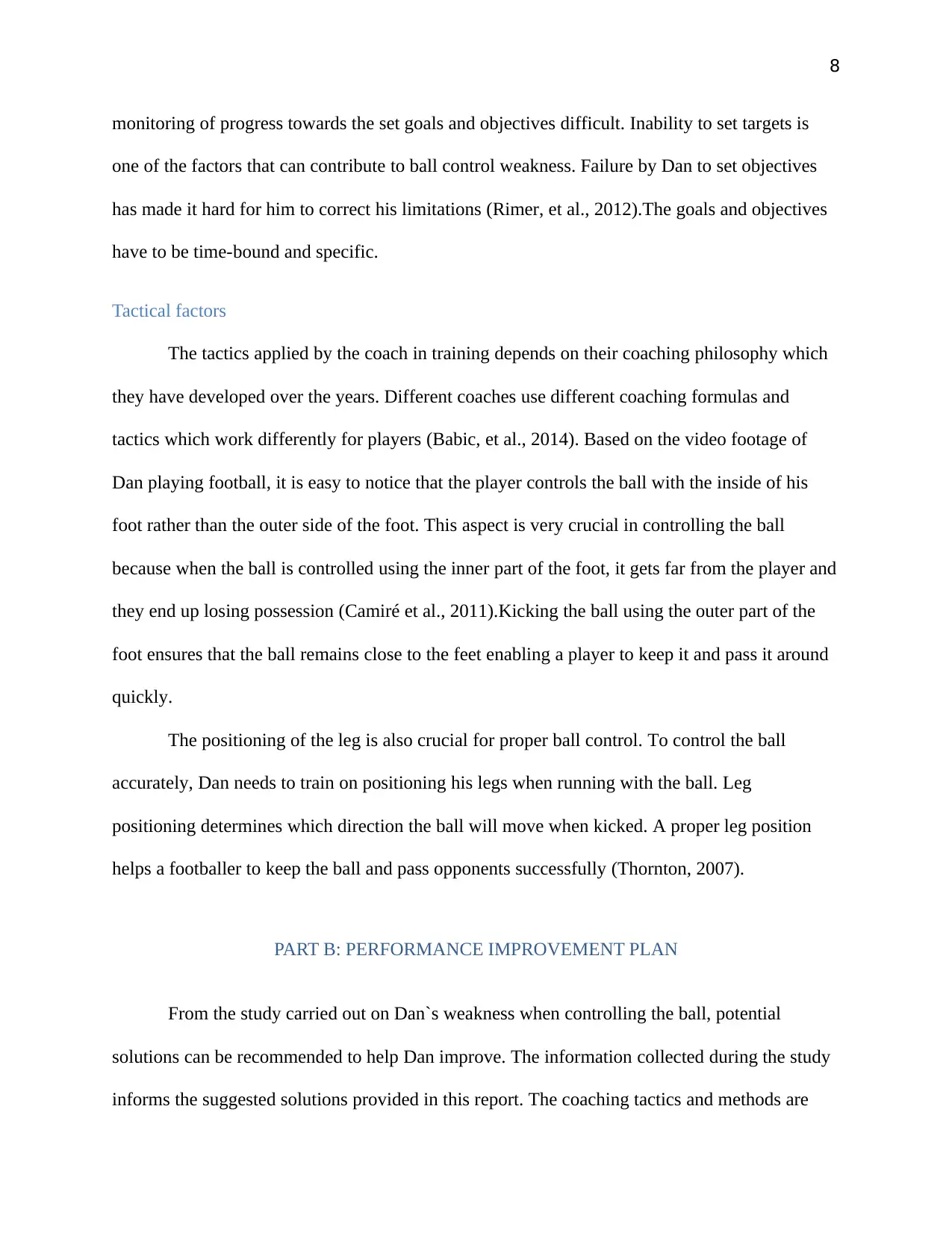
8
monitoring of progress towards the set goals and objectives difficult. Inability to set targets is
one of the factors that can contribute to ball control weakness. Failure by Dan to set objectives
has made it hard for him to correct his limitations (Rimer, et al., 2012).The goals and objectives
have to be time-bound and specific.
Tactical factors
The tactics applied by the coach in training depends on their coaching philosophy which
they have developed over the years. Different coaches use different coaching formulas and
tactics which work differently for players (Babic, et al., 2014). Based on the video footage of
Dan playing football, it is easy to notice that the player controls the ball with the inside of his
foot rather than the outer side of the foot. This aspect is very crucial in controlling the ball
because when the ball is controlled using the inner part of the foot, it gets far from the player and
they end up losing possession (Camiré et al., 2011).Kicking the ball using the outer part of the
foot ensures that the ball remains close to the feet enabling a player to keep it and pass it around
quickly.
The positioning of the leg is also crucial for proper ball control. To control the ball
accurately, Dan needs to train on positioning his legs when running with the ball. Leg
positioning determines which direction the ball will move when kicked. A proper leg position
helps a footballer to keep the ball and pass opponents successfully (Thornton, 2007).
PART B: PERFORMANCE IMPROVEMENT PLAN
From the study carried out on Dan`s weakness when controlling the ball, potential
solutions can be recommended to help Dan improve. The information collected during the study
informs the suggested solutions provided in this report. The coaching tactics and methods are
monitoring of progress towards the set goals and objectives difficult. Inability to set targets is
one of the factors that can contribute to ball control weakness. Failure by Dan to set objectives
has made it hard for him to correct his limitations (Rimer, et al., 2012).The goals and objectives
have to be time-bound and specific.
Tactical factors
The tactics applied by the coach in training depends on their coaching philosophy which
they have developed over the years. Different coaches use different coaching formulas and
tactics which work differently for players (Babic, et al., 2014). Based on the video footage of
Dan playing football, it is easy to notice that the player controls the ball with the inside of his
foot rather than the outer side of the foot. This aspect is very crucial in controlling the ball
because when the ball is controlled using the inner part of the foot, it gets far from the player and
they end up losing possession (Camiré et al., 2011).Kicking the ball using the outer part of the
foot ensures that the ball remains close to the feet enabling a player to keep it and pass it around
quickly.
The positioning of the leg is also crucial for proper ball control. To control the ball
accurately, Dan needs to train on positioning his legs when running with the ball. Leg
positioning determines which direction the ball will move when kicked. A proper leg position
helps a footballer to keep the ball and pass opponents successfully (Thornton, 2007).
PART B: PERFORMANCE IMPROVEMENT PLAN
From the study carried out on Dan`s weakness when controlling the ball, potential
solutions can be recommended to help Dan improve. The information collected during the study
informs the suggested solutions provided in this report. The coaching tactics and methods are
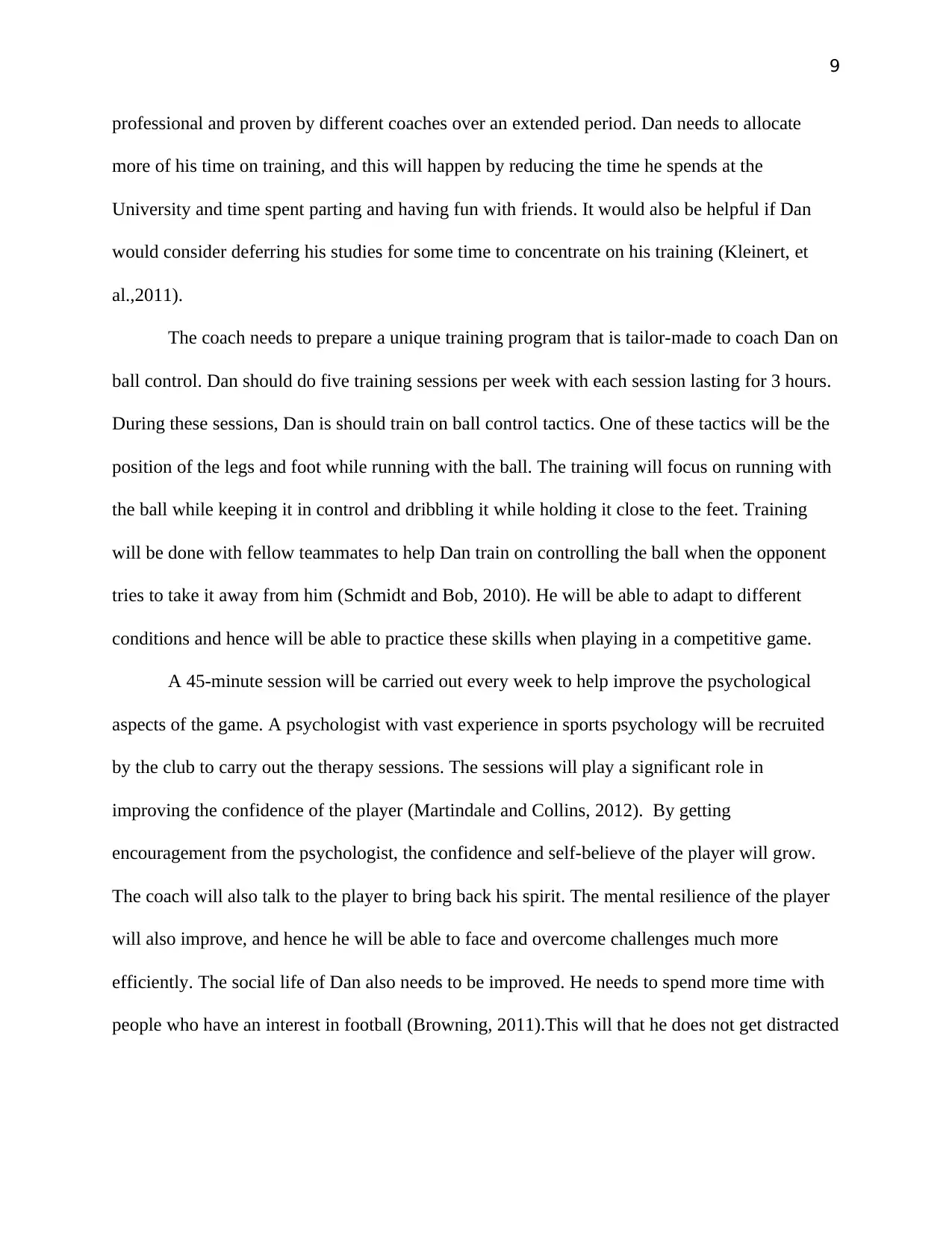
9
professional and proven by different coaches over an extended period. Dan needs to allocate
more of his time on training, and this will happen by reducing the time he spends at the
University and time spent parting and having fun with friends. It would also be helpful if Dan
would consider deferring his studies for some time to concentrate on his training (Kleinert, et
al.,2011).
The coach needs to prepare a unique training program that is tailor-made to coach Dan on
ball control. Dan should do five training sessions per week with each session lasting for 3 hours.
During these sessions, Dan is should train on ball control tactics. One of these tactics will be the
position of the legs and foot while running with the ball. The training will focus on running with
the ball while keeping it in control and dribbling it while holding it close to the feet. Training
will be done with fellow teammates to help Dan train on controlling the ball when the opponent
tries to take it away from him (Schmidt and Bob, 2010). He will be able to adapt to different
conditions and hence will be able to practice these skills when playing in a competitive game.
A 45-minute session will be carried out every week to help improve the psychological
aspects of the game. A psychologist with vast experience in sports psychology will be recruited
by the club to carry out the therapy sessions. The sessions will play a significant role in
improving the confidence of the player (Martindale and Collins, 2012). By getting
encouragement from the psychologist, the confidence and self-believe of the player will grow.
The coach will also talk to the player to bring back his spirit. The mental resilience of the player
will also improve, and hence he will be able to face and overcome challenges much more
efficiently. The social life of Dan also needs to be improved. He needs to spend more time with
people who have an interest in football (Browning, 2011).This will that he does not get distracted
professional and proven by different coaches over an extended period. Dan needs to allocate
more of his time on training, and this will happen by reducing the time he spends at the
University and time spent parting and having fun with friends. It would also be helpful if Dan
would consider deferring his studies for some time to concentrate on his training (Kleinert, et
al.,2011).
The coach needs to prepare a unique training program that is tailor-made to coach Dan on
ball control. Dan should do five training sessions per week with each session lasting for 3 hours.
During these sessions, Dan is should train on ball control tactics. One of these tactics will be the
position of the legs and foot while running with the ball. The training will focus on running with
the ball while keeping it in control and dribbling it while holding it close to the feet. Training
will be done with fellow teammates to help Dan train on controlling the ball when the opponent
tries to take it away from him (Schmidt and Bob, 2010). He will be able to adapt to different
conditions and hence will be able to practice these skills when playing in a competitive game.
A 45-minute session will be carried out every week to help improve the psychological
aspects of the game. A psychologist with vast experience in sports psychology will be recruited
by the club to carry out the therapy sessions. The sessions will play a significant role in
improving the confidence of the player (Martindale and Collins, 2012). By getting
encouragement from the psychologist, the confidence and self-believe of the player will grow.
The coach will also talk to the player to bring back his spirit. The mental resilience of the player
will also improve, and hence he will be able to face and overcome challenges much more
efficiently. The social life of Dan also needs to be improved. He needs to spend more time with
people who have an interest in football (Browning, 2011).This will that he does not get distracted
⊘ This is a preview!⊘
Do you want full access?
Subscribe today to unlock all pages.

Trusted by 1+ million students worldwide
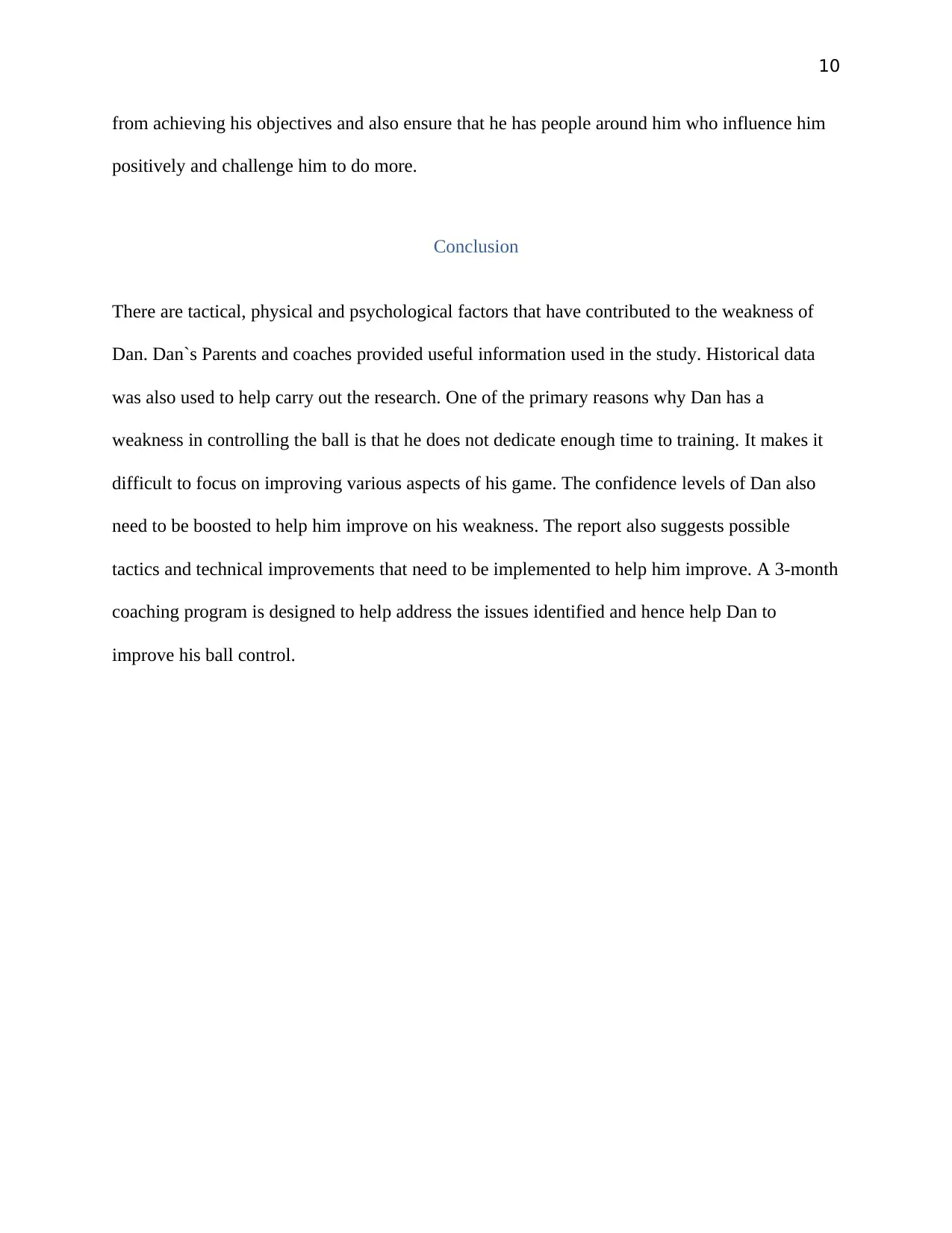
10
from achieving his objectives and also ensure that he has people around him who influence him
positively and challenge him to do more.
Conclusion
There are tactical, physical and psychological factors that have contributed to the weakness of
Dan. Dan`s Parents and coaches provided useful information used in the study. Historical data
was also used to help carry out the research. One of the primary reasons why Dan has a
weakness in controlling the ball is that he does not dedicate enough time to training. It makes it
difficult to focus on improving various aspects of his game. The confidence levels of Dan also
need to be boosted to help him improve on his weakness. The report also suggests possible
tactics and technical improvements that need to be implemented to help him improve. A 3-month
coaching program is designed to help address the issues identified and hence help Dan to
improve his ball control.
from achieving his objectives and also ensure that he has people around him who influence him
positively and challenge him to do more.
Conclusion
There are tactical, physical and psychological factors that have contributed to the weakness of
Dan. Dan`s Parents and coaches provided useful information used in the study. Historical data
was also used to help carry out the research. One of the primary reasons why Dan has a
weakness in controlling the ball is that he does not dedicate enough time to training. It makes it
difficult to focus on improving various aspects of his game. The confidence levels of Dan also
need to be boosted to help him improve on his weakness. The report also suggests possible
tactics and technical improvements that need to be implemented to help him improve. A 3-month
coaching program is designed to help address the issues identified and hence help Dan to
improve his ball control.
Paraphrase This Document
Need a fresh take? Get an instant paraphrase of this document with our AI Paraphraser
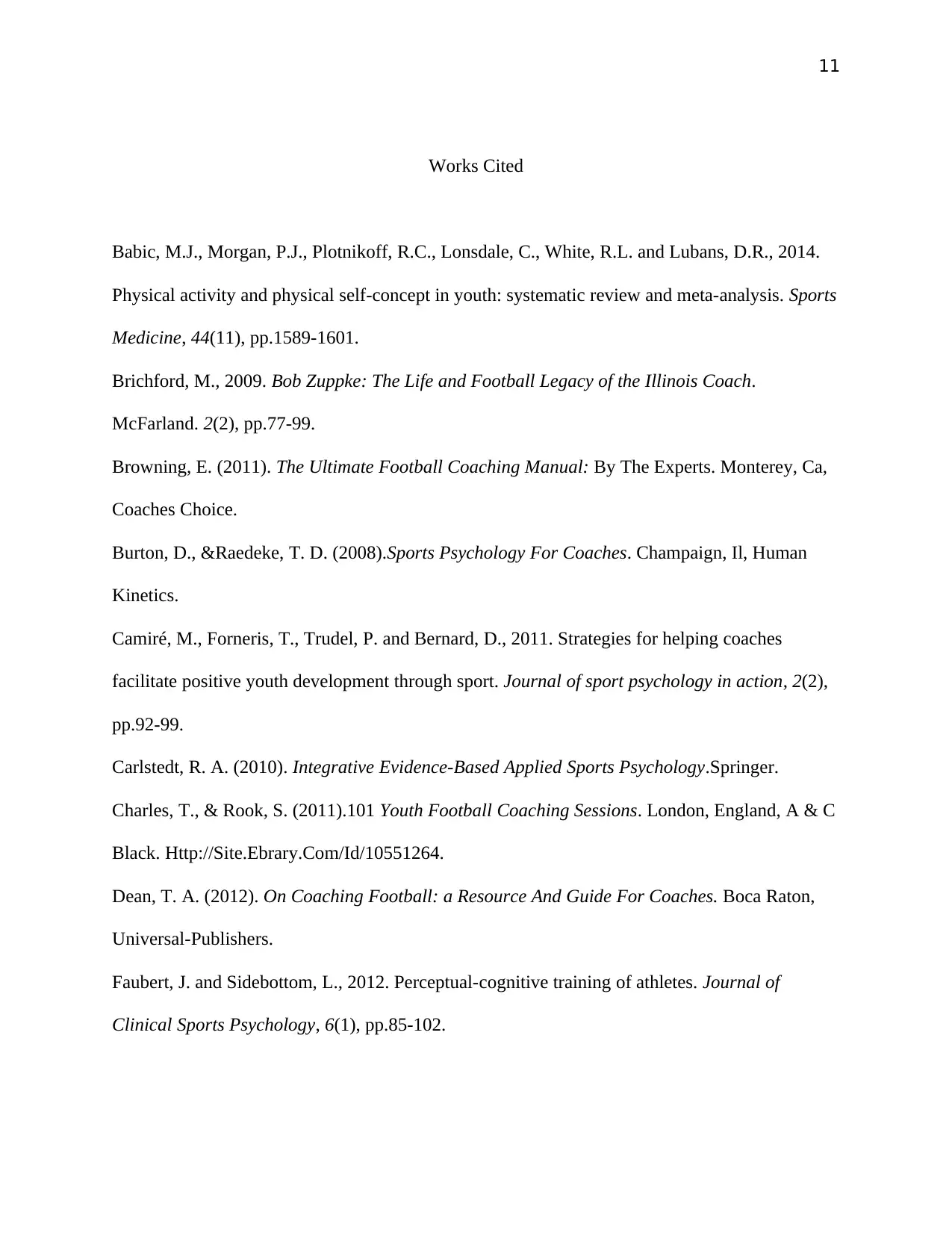
11
Works Cited
Babic, M.J., Morgan, P.J., Plotnikoff, R.C., Lonsdale, C., White, R.L. and Lubans, D.R., 2014.
Physical activity and physical self-concept in youth: systematic review and meta-analysis. Sports
Medicine, 44(11), pp.1589-1601.
Brichford, M., 2009. Bob Zuppke: The Life and Football Legacy of the Illinois Coach.
McFarland. 2(2), pp.77-99.
Browning, E. (2011). The Ultimate Football Coaching Manual: By The Experts. Monterey, Ca,
Coaches Choice.
Burton, D., &Raedeke, T. D. (2008).Sports Psychology For Coaches. Champaign, Il, Human
Kinetics.
Camiré, M., Forneris, T., Trudel, P. and Bernard, D., 2011. Strategies for helping coaches
facilitate positive youth development through sport. Journal of sport psychology in action, 2(2),
pp.92-99.
Carlstedt, R. A. (2010). Integrative Evidence-Based Applied Sports Psychology.Springer.
Charles, T., & Rook, S. (2011).101 Youth Football Coaching Sessions. London, England, A & C
Black. Http://Site.Ebrary.Com/Id/10551264.
Dean, T. A. (2012). On Coaching Football: a Resource And Guide For Coaches. Boca Raton,
Universal-Publishers.
Faubert, J. and Sidebottom, L., 2012. Perceptual-cognitive training of athletes. Journal of
Clinical Sports Psychology, 6(1), pp.85-102.
Works Cited
Babic, M.J., Morgan, P.J., Plotnikoff, R.C., Lonsdale, C., White, R.L. and Lubans, D.R., 2014.
Physical activity and physical self-concept in youth: systematic review and meta-analysis. Sports
Medicine, 44(11), pp.1589-1601.
Brichford, M., 2009. Bob Zuppke: The Life and Football Legacy of the Illinois Coach.
McFarland. 2(2), pp.77-99.
Browning, E. (2011). The Ultimate Football Coaching Manual: By The Experts. Monterey, Ca,
Coaches Choice.
Burton, D., &Raedeke, T. D. (2008).Sports Psychology For Coaches. Champaign, Il, Human
Kinetics.
Camiré, M., Forneris, T., Trudel, P. and Bernard, D., 2011. Strategies for helping coaches
facilitate positive youth development through sport. Journal of sport psychology in action, 2(2),
pp.92-99.
Carlstedt, R. A. (2010). Integrative Evidence-Based Applied Sports Psychology.Springer.
Charles, T., & Rook, S. (2011).101 Youth Football Coaching Sessions. London, England, A & C
Black. Http://Site.Ebrary.Com/Id/10551264.
Dean, T. A. (2012). On Coaching Football: a Resource And Guide For Coaches. Boca Raton,
Universal-Publishers.
Faubert, J. and Sidebottom, L., 2012. Perceptual-cognitive training of athletes. Journal of
Clinical Sports Psychology, 6(1), pp.85-102.
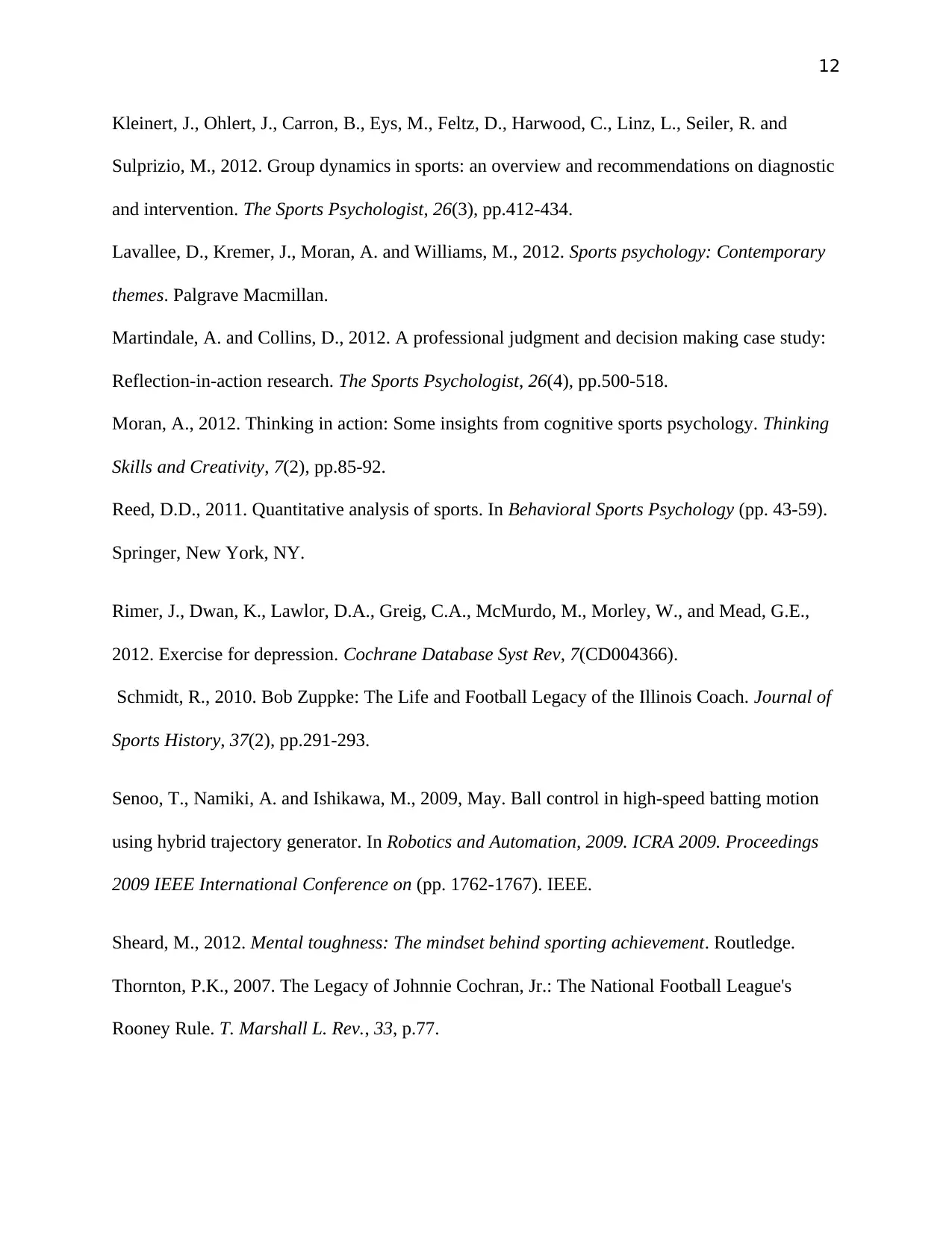
12
Kleinert, J., Ohlert, J., Carron, B., Eys, M., Feltz, D., Harwood, C., Linz, L., Seiler, R. and
Sulprizio, M., 2012. Group dynamics in sports: an overview and recommendations on diagnostic
and intervention. The Sports Psychologist, 26(3), pp.412-434.
Lavallee, D., Kremer, J., Moran, A. and Williams, M., 2012. Sports psychology: Contemporary
themes. Palgrave Macmillan.
Martindale, A. and Collins, D., 2012. A professional judgment and decision making case study:
Reflection-in-action research. The Sports Psychologist, 26(4), pp.500-518.
Moran, A., 2012. Thinking in action: Some insights from cognitive sports psychology. Thinking
Skills and Creativity, 7(2), pp.85-92.
Reed, D.D., 2011. Quantitative analysis of sports. In Behavioral Sports Psychology (pp. 43-59).
Springer, New York, NY.
Rimer, J., Dwan, K., Lawlor, D.A., Greig, C.A., McMurdo, M., Morley, W., and Mead, G.E.,
2012. Exercise for depression. Cochrane Database Syst Rev, 7(CD004366).
Schmidt, R., 2010. Bob Zuppke: The Life and Football Legacy of the Illinois Coach. Journal of
Sports History, 37(2), pp.291-293.
Senoo, T., Namiki, A. and Ishikawa, M., 2009, May. Ball control in high-speed batting motion
using hybrid trajectory generator. In Robotics and Automation, 2009. ICRA 2009. Proceedings
2009 IEEE International Conference on (pp. 1762-1767). IEEE.
Sheard, M., 2012. Mental toughness: The mindset behind sporting achievement. Routledge.
Thornton, P.K., 2007. The Legacy of Johnnie Cochran, Jr.: The National Football League's
Rooney Rule. T. Marshall L. Rev., 33, p.77.
Kleinert, J., Ohlert, J., Carron, B., Eys, M., Feltz, D., Harwood, C., Linz, L., Seiler, R. and
Sulprizio, M., 2012. Group dynamics in sports: an overview and recommendations on diagnostic
and intervention. The Sports Psychologist, 26(3), pp.412-434.
Lavallee, D., Kremer, J., Moran, A. and Williams, M., 2012. Sports psychology: Contemporary
themes. Palgrave Macmillan.
Martindale, A. and Collins, D., 2012. A professional judgment and decision making case study:
Reflection-in-action research. The Sports Psychologist, 26(4), pp.500-518.
Moran, A., 2012. Thinking in action: Some insights from cognitive sports psychology. Thinking
Skills and Creativity, 7(2), pp.85-92.
Reed, D.D., 2011. Quantitative analysis of sports. In Behavioral Sports Psychology (pp. 43-59).
Springer, New York, NY.
Rimer, J., Dwan, K., Lawlor, D.A., Greig, C.A., McMurdo, M., Morley, W., and Mead, G.E.,
2012. Exercise for depression. Cochrane Database Syst Rev, 7(CD004366).
Schmidt, R., 2010. Bob Zuppke: The Life and Football Legacy of the Illinois Coach. Journal of
Sports History, 37(2), pp.291-293.
Senoo, T., Namiki, A. and Ishikawa, M., 2009, May. Ball control in high-speed batting motion
using hybrid trajectory generator. In Robotics and Automation, 2009. ICRA 2009. Proceedings
2009 IEEE International Conference on (pp. 1762-1767). IEEE.
Sheard, M., 2012. Mental toughness: The mindset behind sporting achievement. Routledge.
Thornton, P.K., 2007. The Legacy of Johnnie Cochran, Jr.: The National Football League's
Rooney Rule. T. Marshall L. Rev., 33, p.77.
⊘ This is a preview!⊘
Do you want full access?
Subscribe today to unlock all pages.

Trusted by 1+ million students worldwide
1 out of 13
Related Documents
Your All-in-One AI-Powered Toolkit for Academic Success.
+13062052269
info@desklib.com
Available 24*7 on WhatsApp / Email
![[object Object]](/_next/static/media/star-bottom.7253800d.svg)
Unlock your academic potential
Copyright © 2020–2025 A2Z Services. All Rights Reserved. Developed and managed by ZUCOL.





